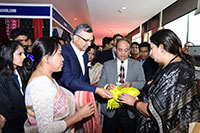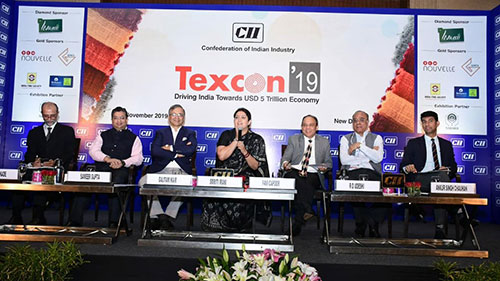Texcon-the annual textile conference organised by CII brings together leading players of the Indian textile industry, global buyers, and policymakers to deliberate on key areas of business, including regional as well as global issues concerning the sector. The conference also focused on emerging export opportunities and how Indian industries can leverage these for growth.
 With 15 per cent share in the country’s export earnings and a 5 per cent share in its annual GDP, India’s textile and apparel industry holds a prominent position in the country’s economy. This has been achieved mainly due to easy access to raw materials that the country offers along with a pool of skilled manpower and its lucrative central and state policies. Also, the presence of complete value chain in textile and apparels benefits the sector.
With 15 per cent share in the country’s export earnings and a 5 per cent share in its annual GDP, India’s textile and apparel industry holds a prominent position in the country’s economy. This has been achieved mainly due to easy access to raw materials that the country offers along with a pool of skilled manpower and its lucrative central and state policies. Also, the presence of complete value chain in textile and apparels benefits the sector.
However, despite these inherent advantages, the Indian industry lags behind competing nations such as: Bangladesh, China, Vietnam etc, and as it is yet to realise its full potential as a supplier to the global markets.
Need to focus on exports
One of the key factors that differentiate India from all these nations is their focus on large, world class manufacturing set-ups across the value chain, crossborder innovations, research and prototype development, and sustainable fashion approach to withstand uncertain consumer demand. “If India aims to grow into a $5 trillion economy, it needs to rebrand itself as an export-driven economy,” said Ravi Kapoor, Textile Secretary at Texcon 2019 being held from November 4-5, 2019 in New Delhi. “However, it is not essential that a country makes everything under the sun. It needs to concentrate on four core areas: petroleum, gems and jewellery, engineering and textiles. These four constitute the chunk of India’s exports.”
Of these, India buys petroleum from outside, does a 6 to 7 per cent valuation on it and exports it to other countries. We also buy gems, stones and diamonds from outside, cut and polish them then add 5 to 7 per cent and valuation and export them. “It is only in the textile industry that we do the entire processing from fiber. This is the only sector that offers us maximum potential to explore. If we have to grow our textiles, we should concentrate on manmade fibers besides neutralising inverted duty structures,” Kapoor explained.
Texcon-the annual textile conference organised by CII brings together leading players of the Indian textile industry, global buyers, and policymakers to deliberate on key areas of business, including regional as well as global issues concerning the sector. The conference also focused on emerging export opportunities and how Indian industries can leverage these for growth.
Held on November 4 to 5, 2019 at the Lalit Hotel, New Delhi, Texcon 2019 conveys the importance of integrating, thinking and acting big in order to achieve global eminence. The theme of the conference this year is: ‘Rise of Indian Textile & Apparel Industry: What is the Need of the Hour’.












